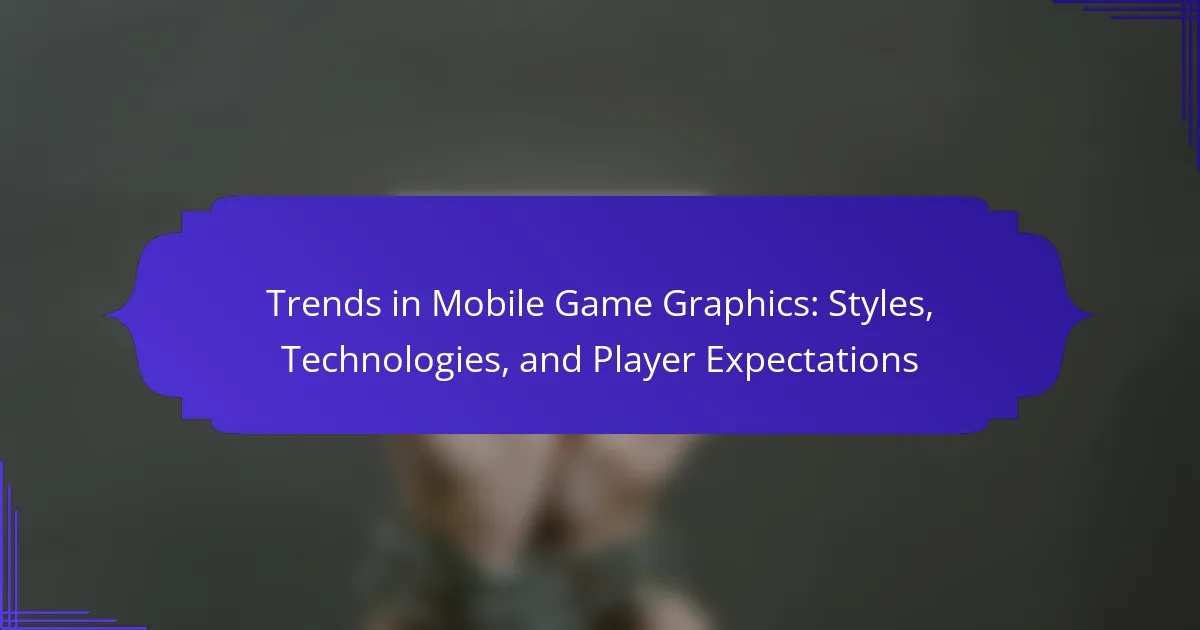Mobile game graphics are evolving rapidly, driven by player expectations for realism and immersive experiences. Current trends highlight the use of advanced technologies like HDR and real-time ray tracing, alongside unique art styles such as low-poly and pixel art. Regional preferences influence design choices, while challenges in performance optimization remain critical. Future advancements will focus on enhancing visual fidelity and responsiveness across diverse devices.
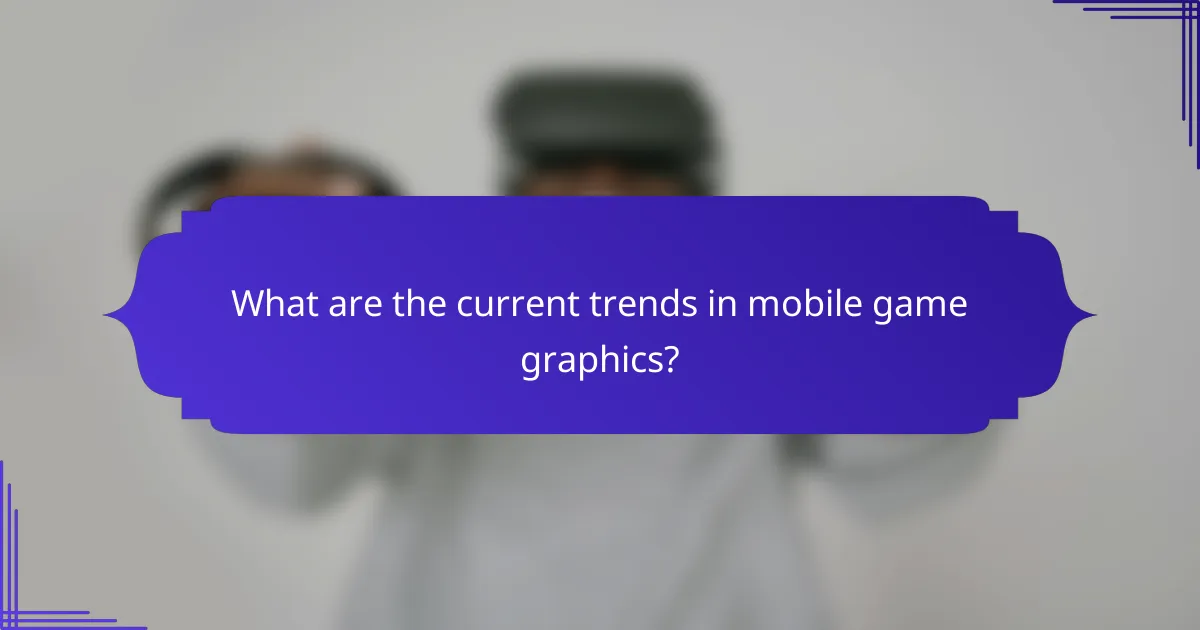
What are the current trends in mobile game graphics?
Current trends in mobile game graphics focus on realism, stylization, and immersive experiences. High dynamic range (HDR) and 3D rendering technologies enhance visual fidelity. Players expect seamless animations and adaptive graphics that adjust to device capabilities. Unique art styles, such as low-poly and pixel art, are gaining popularity, offering distinctive aesthetics. Additionally, augmented reality (AR) integration is reshaping gameplay, creating interactive environments. As a result, developers prioritize optimizing performance while delivering visually stunning content.
How are graphic styles evolving in mobile games?
Graphic styles in mobile games are evolving towards more immersive and stylized aesthetics. Enhanced graphics engines allow for realistic lighting, textures, and animations, elevating player experiences. Unique attributes like hand-drawn art or minimalist designs are gaining popularity, catering to diverse player preferences. As a result, players expect high-quality visuals that complement engaging gameplay, driving developers to innovate continuously.
Which technologies are driving advancements in mobile game graphics?
Advancements in mobile game graphics are driven by technologies like real-time ray tracing, machine learning, and enhanced graphics engines. These innovations improve visual fidelity and performance, meeting player expectations for immersive experiences. Real-time ray tracing, for example, allows for realistic lighting and reflections, while machine learning optimizes graphics rendering, reducing load times and enhancing frame rates. Additionally, powerful graphics engines like Unity and Unreal Engine facilitate the integration of these technologies into mobile games, pushing graphical boundaries further.
What role do player expectations play in graphic design choices?
Player expectations significantly influence graphic design choices in mobile games. Designers prioritize aesthetics that resonate with target audiences, enhancing engagement. Trends indicate a shift towards vibrant colors and stylized graphics, aligning with players’ desire for immersive experiences. Additionally, incorporating familiar visual elements can evoke nostalgia, further meeting player expectations. Understanding these dynamics allows developers to create visually appealing games that attract and retain users.
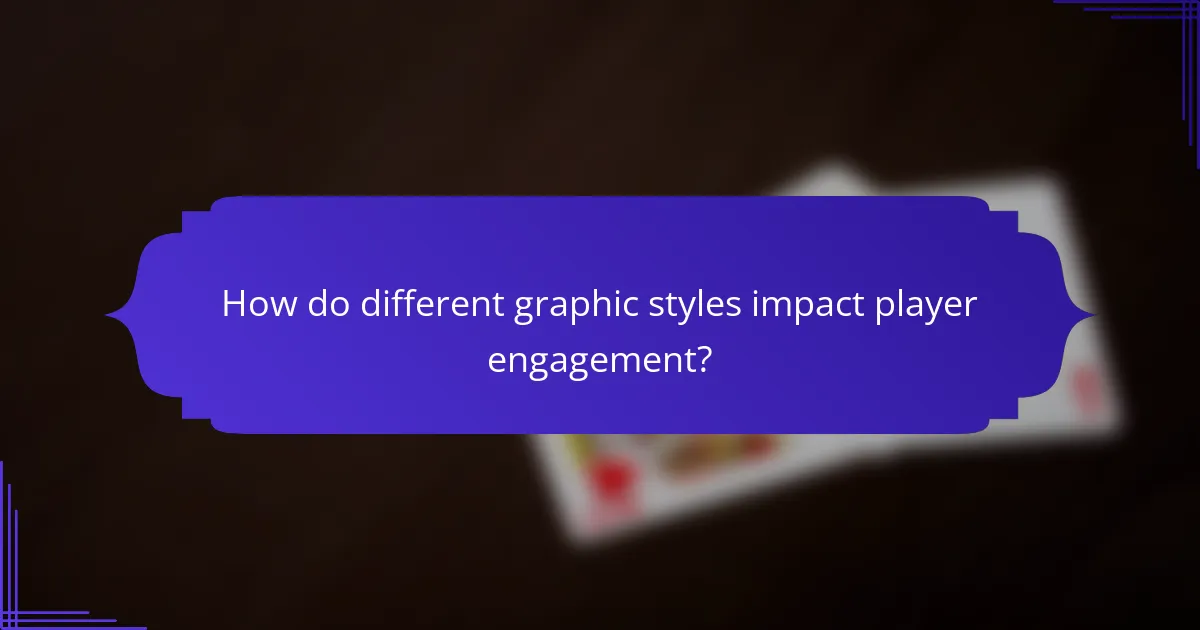
How do different graphic styles impact player engagement?
Different graphic styles significantly impact player engagement by influencing visual appeal, emotional connection, and gameplay experience. For example, realistic graphics can enhance immersion, while stylized designs may foster creativity and uniqueness. Additionally, players often have specific expectations based on genre trends, which can affect their overall satisfaction. Unique attributes, such as color schemes and animation fluidity, also play a role in capturing attention and retaining interest.
What are the most popular visual styles among mobile gamers?
The most popular visual styles among mobile gamers include realistic graphics, cartoonish designs, pixel art, and minimalist aesthetics. These styles cater to diverse player preferences and enhance engagement. Realistic graphics provide immersive experiences, while cartoonish designs appeal to casual gamers. Pixel art evokes nostalgia, and minimalist aesthetics focus on simplicity and clarity. Each style influences player expectations and gameplay experiences.
How does art direction influence user retention and satisfaction?
Art direction significantly enhances user retention and satisfaction in mobile games by creating visually appealing experiences. Engaging graphics and cohesive styles attract players, encouraging longer play sessions. High-quality art can evoke emotions, making games more memorable. Additionally, innovative technologies, such as 3D rendering and augmented reality, elevate player expectations, leading to increased satisfaction. Effective art direction aligns with player preferences, ensuring that graphics not only captivate but also enhance gameplay mechanics, thus fostering loyalty.
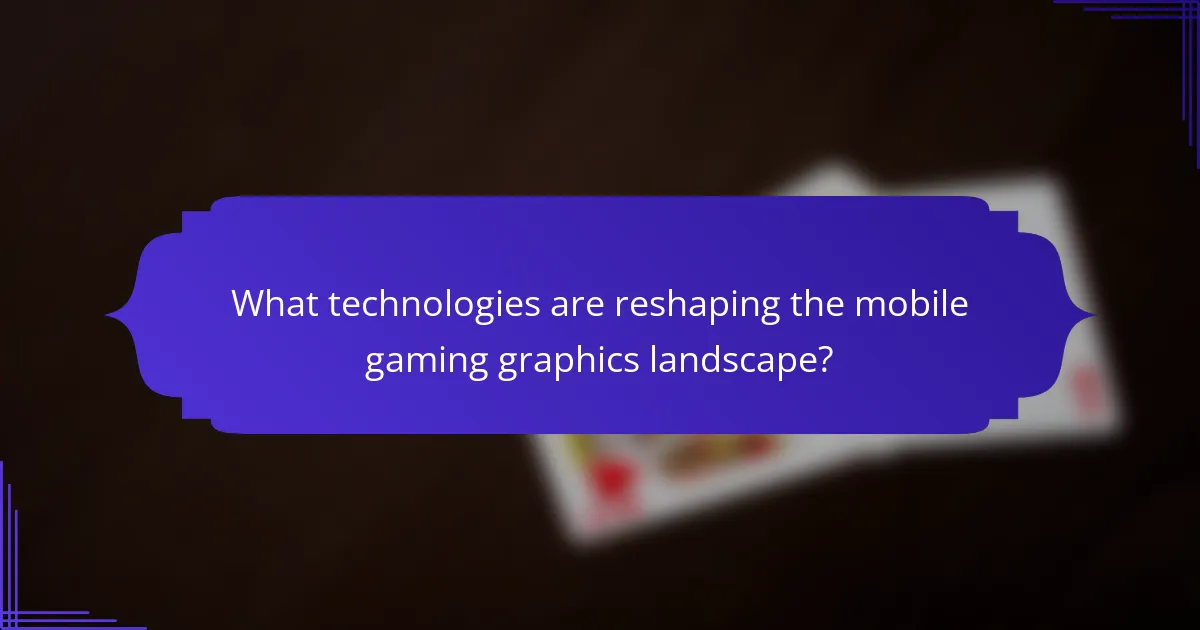
What technologies are reshaping the mobile gaming graphics landscape?
Advanced technologies like real-time ray tracing, machine learning, and cloud gaming are significantly transforming mobile game graphics. These innovations enhance visual fidelity and optimize performance, allowing for immersive experiences. Real-time ray tracing provides realistic lighting and shadows, while machine learning improves texture resolution and frame rates. Cloud gaming enables high-quality graphics on devices with limited processing power, broadening access to advanced gaming experiences. As a result, player expectations are evolving, demanding more visually stunning and fluid gameplay.
How do augmented reality and virtual reality affect graphics in mobile games?
Augmented reality and virtual reality significantly enhance graphics in mobile games by providing immersive experiences and realistic visuals. These technologies enable developers to create dynamic environments and interactive elements that engage players more deeply.
Augmented reality overlays digital graphics onto the real world, enhancing visual fidelity and interaction. This leads to unique gameplay mechanics that blend physical and digital spaces. Virtual reality, on the other hand, immerses players in fully rendered 3D environments, pushing the limits of graphic detail and animation fluidity.
The use of advanced rendering techniques, such as ray tracing and 3D modeling, has become more prevalent due to these technologies. As a result, player expectations have shifted toward higher quality graphics and more engaging gameplay experiences. Developers must adapt to these trends to meet the demands of an increasingly discerning audience.
Which rendering techniques are becoming standard in mobile game development?
Real-time rendering and advanced shading techniques are becoming standard in mobile game development. These methods enhance visual fidelity and player immersion. Techniques like physically-based rendering (PBR) improve material realism, while dynamic lighting and shadowing create lifelike environments. Additionally, the use of machine learning for texture generation is gaining traction, allowing for more efficient asset creation. As mobile hardware evolves, developers increasingly adopt these technologies to meet player expectations for high-quality graphics.

What unique attributes define standout mobile game graphics?
Unique attributes that define standout mobile game graphics include high-resolution textures, dynamic lighting effects, and fluid animations. These elements enhance visual fidelity and immersion, meeting player expectations for realism. Additionally, unique art styles, such as cel-shading or pixel art, differentiate games and create memorable aesthetics. Innovative technologies like real-time rendering and augmented reality further elevate graphics, providing unique gaming experiences.
How do narrative-driven graphics enhance player experience?
Narrative-driven graphics significantly enhance player experience by immersing players in the game’s story. These graphics create emotional connections through visual storytelling, improving engagement and retention. For example, dynamic character animations and detailed environments convey narrative depth, making gameplay more compelling. Enhanced graphics also meet player expectations for realism and artistic expression, driving innovation in mobile game design.
What innovative uses of 3D graphics are emerging in mobile games?
Innovative uses of 3D graphics in mobile games include enhanced realism, immersive environments, and interactive storytelling. These advancements improve player engagement and create unique gaming experiences. Techniques such as procedural generation and augmented reality are becoming more prevalent, allowing developers to craft dynamic worlds. Additionally, real-time rendering is pushing graphical fidelity, enabling lifelike character animations and detailed textures.

How do regional preferences influence graphic design in mobile games?
Regional preferences significantly shape graphic design in mobile games by reflecting cultural aesthetics and player expectations. For instance, Asian markets often favor vibrant colors and intricate designs, while Western audiences may prefer minimalistic and sleek visuals. This divergence influences design choices, such as character appearance and interface layout, ensuring that games resonate with local tastes. Additionally, regional trends can dictate the use of specific technologies, like augmented reality, which may be more popular in certain areas. Understanding these preferences helps developers create engaging experiences tailored to diverse audiences.
What specific graphic trends are popular in North America versus Europe?
North America favors vibrant, cartoonish graphics, while Europe leans towards realistic, detailed styles. Both regions utilize advanced technologies like 3D rendering and augmented reality, but player expectations differ. North American players often seek engaging, casual experiences, whereas European players prefer depth and narrative complexity.
How do cultural factors shape player expectations for graphics?
Cultural factors significantly influence player expectations for graphics in mobile games. Different cultures prioritize distinct visual styles and narrative elements, shaping how players perceive quality and immersion. For instance, players from regions with strong artistic traditions may favor stylized graphics, while others might expect hyper-realistic visuals. Additionally, cultural themes and symbols can enhance relatability, driving player engagement. Understanding these preferences allows developers to tailor graphics that resonate with diverse audiences, ultimately enhancing user satisfaction.
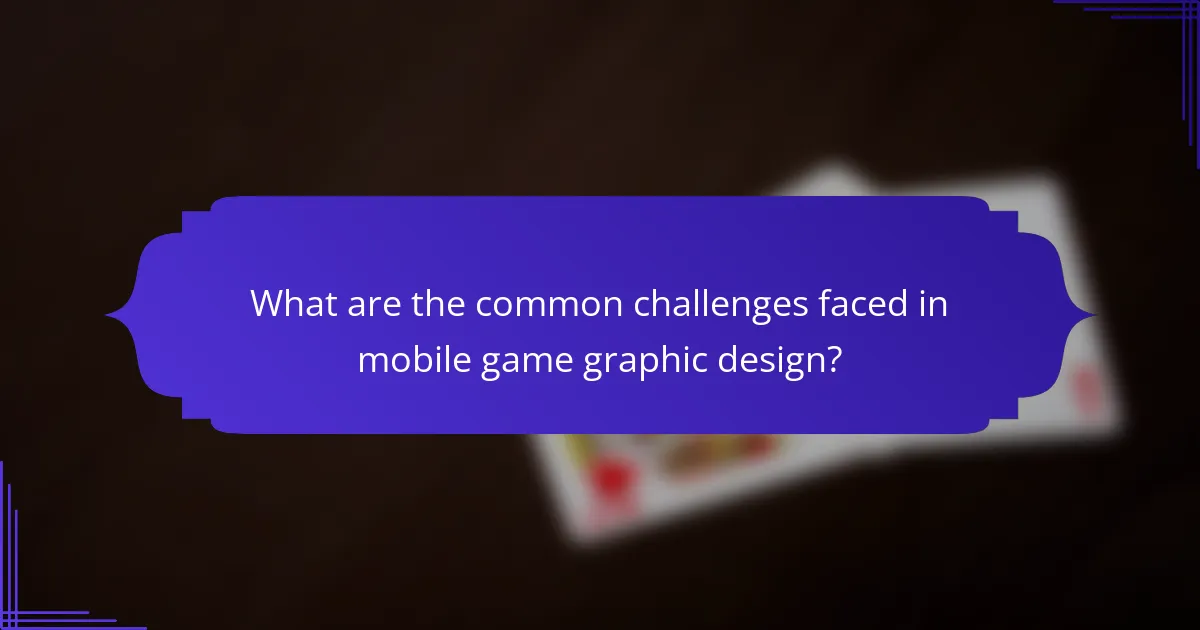
What are the common challenges faced in mobile game graphic design?
Mobile game graphic design faces challenges such as maintaining performance across devices, meeting player expectations for quality, and adapting to evolving technology. Designers must balance aesthetic appeal with optimization to ensure smooth gameplay. Additionally, creating unique styles that stand out in a saturated market can be difficult. Collaboration among artists, developers, and marketers is essential to address these issues effectively.
What limitations do developers encounter with mobile hardware?
Developers encounter several limitations with mobile hardware that impact game graphics. These include lower processing power, limited memory, and varying screen resolutions.
Mobile devices often have less powerful GPUs compared to consoles and PCs, restricting complex graphics rendering. Memory constraints can limit asset sizes, affecting texture quality and overall visual fidelity. Additionally, different screen resolutions across devices complicate the development of consistent graphics, requiring adaptive design strategies.
As a result, developers must optimize graphics to balance performance and visual quality, often leading to compromises in detail and effects.
How do budget constraints affect graphic quality in mobile games?
Budget constraints significantly limit graphic quality in mobile games. Developers often prioritize performance over aesthetics to ensure smooth gameplay on diverse devices. Lower budgets restrict access to advanced technologies and skilled artists, resulting in simplified graphics and reduced detail. As mobile gaming evolves, player expectations continue to rise, creating a challenge for developers working within tight financial parameters. Enhanced graphics often require higher investment in both technology and talent, which may not be feasible for all developers.

What future trends can we anticipate in mobile game graphics?
Future trends in mobile game graphics will focus on realism, improved performance, and enhanced player immersion. Technologies like ray tracing and AI-driven graphics will become standard, enabling lifelike environments and characters. Players will expect higher frame rates and adaptive graphics that respond to device capabilities. Unique styles, such as hyper-realism and stylized visuals, will cater to diverse preferences, ensuring a broad appeal. As mobile hardware advances, the gap between console and mobile graphics will continue to narrow.
How might AI and machine learning transform graphic design in mobile gaming?
AI and machine learning will significantly enhance graphic design in mobile gaming by automating complex tasks, personalizing experiences, and improving visual fidelity. These technologies can analyze player behavior to create adaptive graphics that respond to user preferences.
One key trend is the use of AI-driven tools that streamline the design process, allowing developers to generate assets more efficiently. For instance, machine learning algorithms can assist in texture generation, character modeling, and environmental design. This reduces production time and costs while maintaining high-quality visuals.
Another important aspect is the ability to create dynamic and immersive environments. AI can help in procedural generation, enabling unique game worlds that evolve based on player interactions. This not only enhances player engagement but also meets the growing expectation for diverse and visually stunning graphics.
Finally, AI and machine learning can optimize performance by adjusting graphical settings in real-time based on device capabilities. This ensures that players receive the best possible experience without sacrificing visual quality. As a result, these technologies are set to redefine player expectations and standards in mobile game graphics.
What emerging technologies could redefine player expectations for graphics?
Emerging technologies such as ray tracing, machine learning, and augmented reality are set to redefine player expectations for graphics. Ray tracing enhances realism by simulating light behavior, creating lifelike environments. Machine learning optimizes graphics rendering, improving performance and visual quality. Augmented reality offers immersive experiences, blending digital elements with the real world. These innovations push the boundaries of mobile game graphics, leading to higher player engagement and satisfaction.
What best practices should developers follow for optimizing mobile game graphics?
Developers should prioritize performance, resolution, and optimization techniques to enhance mobile game graphics. Efficient texture compression reduces load times while maintaining quality. Implementing dynamic resolution scaling adapts graphics based on device performance, ensuring smooth gameplay. Utilizing modern rendering techniques like physically-based rendering enhances realism. Testing on various devices identifies performance bottlenecks, allowing for tailored optimizations. Regular updates based on player feedback can further meet evolving player expectations.
